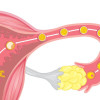Histeroskopi bermanfaat dalam penanganan infertilitas karena gangguan intrauterin telah diketahui berperan dalam kegagalan implantasi dan keberhasilan reproduksi. Histeroskopi memungkinkan visualisasi langsung rongga uterus, sehingga kelainan seperti polip endometrium atau septum uterus dapat diidentifikasi dan ditangani secara minimal invasif dalam satu sesi tindakan.[1,2]
Infertilitas ditandai dengan kegagalan untuk mempertahankan kehamilan secara klinis, setelah 12 bulan berhubungan seksual secara regular, tanpa proteksi, atau ketidakmampuan seseorang atau bersama rekannya untuk bereproduksi. Infertilitas juga dapat diartikan sebagai penyakit yang menyebabkan disabilitas pada kerusakan fungsi reproduksi.[3,4]
Infertilitas memiliki dampak pada hubungan bagi kedua pasangan, di mana dilaporkan angka perceraian mencapai 3,5 kali lebih tinggi pada wanita yang infertil. Selain itu, dampak yang ditimbulkan juga meliputi aspek psikologis, sosial, penderitaan pribadi, dan disfungsi seksual. Oleh karena itu, masalah infertilitas dapat menurunkan kualitas hidup pasangan yang mengalaminya.[4,5]
Angka Kejadian dan Signifikansi Medis Infertilitas
Angka kejadian infertilitas pada wanita usia reproduksi adalah 1:7 pasangan di negara maju, dan 1:4 pasangan di negara berkembang. Kondisi infertilitas dapat mencapai 30% pada daerah Asia selatan, Afrika, dan Eropa Tengah. Faktor infertilitas laki-laki sendiri menyumbang 20-30% kasus.
Secara keseluruhan, infertilitas ditemukan pada 8-12% pasangan di seluruh dunia, di mana infertilitas sekunder adalah penyebab paling sering pada wanita. Faktor perempuan sendiri menyumbang 10-20% kasus infertilitas, dan menyumbang 37% kasus pada pasangan yang infertil.[2,5,6]
Kemungkinan Penyebab Infertilitas pada Wanita
Secara umum, gangguan kesuburan pada wanita bisa disebabkan oleh gangguan ovulasi, gangguan pembuahan, dan gangguan implantasi. Yang paling banyak menyebabkan gangguan kesuburan adalah faktor gangguan ovulasi (25-30%), dan faktor kelainan uterus (10-15%).
Kelainan pada uterus dapat berupa ada polip uterus, mioma submukosa, dan sindrom Asherman. Faktor-faktor tersebut dapat menyebabkan gangguan kesuburan, baik tunggal maupun kombinasi, dengan faktor lainnya. Bila pemeriksaan infertilitas standar sudah dilakukan, dan tetap tidak ditemukan penyebabnya, maka dikatakan infertilitas idiopatik.[7,8]
Beberapa faktor risiko lain yang dapat menurunkan angka kesuburan wanita adalah usia yang lanjut, indeks massa tubuh yang tinggi, riwayat operasi daerah pelvis sebelumnya, konsumsi alkohol, kelainan genetik, gangguan imunitas, riwayat infeksi di panggul, riwayat diabetes melitus, thrombophilia, dan stress.[9]
Peran Histeroskopi pada Kasus Infertilitas
Tinjauan terhadap 9 uji klinis (n=2.976) menunjukkan bahwa histeroskopi meningkatkan luaran reproduksi pada infertilitas. Meski demikian, perlu diketahui bahwa kualitas buktinya masih rendah-sedang.
Menurut tinjauan ini, histeroskopi meningkatkan live birth rate (RR 1,48) dan pregnancy rate (RR 1,45), baik sebelum in vitro fertilization/IVF atau intracytoplasmic sperm injection/ICSI pertama maupun setelah kegagalan implantasi berulang. Histeroskopi operatif juga meningkatkan pregnancy rate (RR 2,13) pada kasus dengan kelainan intrauterin seperti polip atau mioma.[7]
Tinjauan sistematik lain mengevaluasi penelitian-penelitian yang membandingkan wanita subfertil idiopatik yang melakukan skrining histeroskopi (1.836 subjek) dengan yang tidak melakukan histeroskopi (1.914 subjek) sebelum IVF. Sebelumnya subjek telah melakukan pemeriksaan pencitraan rutin dan tidak ditemukan kelainan pada rongga rahim.
Hasil tinjauan menunjukkan bahwa tidak ada bukti berkualitas tinggi untuk mendukung penggunaan histeroskopi secara rutin sebagai alat skrining pada wanita subfertil dengan USG pelvis atau histerosalfingografi (HSG) normal. Meski demikian, terdapat bukti kualitas rendah bahwa histeroskopi pra-IVF dikaitkan dengan peningkatan live birth rate (RR 1,26) dan pregnancy rate (RR 1,32).[10]
Tinjauan lain (2023) terhadap 15 uji klinis acak yang melibatkan 5.038 wanita infertil, menunjukkan bahwa histeroskopi dapat meningkatkan luaran reproduksi. Histeroskopi dilaporkan meningkatkan live birth rate (RR 1,24) dan pregnancy rate (RR 1,36), terutama pada wanita dengan riwayat kegagalan implantasi sebelumnya. Pada kasus dengan kelainan intrauterin, histeroskopi operatif juga dilaporkan meningkatkan pregnancy rate (RR 2,13).[11]
Kelebihan dan Keterbatasan Penggunaan Histeroskopi
Histeroskopi dapat mendeteksi kelainan kavum uteri yang tidak tampak pada USG transvaginal, termasuk adanya adhesi intrauterin, polip endometrium, dan fibroid submukosa, serta memungkinkan tindakan korektif dalam satu prosedur. Beberapa studi juga telah menunjukkan bahwa histeroskopi efektif meningkatkan angka konsepsi pada pasien dengan infertilitas.
Meski demikian, perlu diketahui bahwa bukti ilmiah yang mendukung manfaat histeroskopi pada pasien infertil tanpa kelainan intrauterin masih rendah dan hasil penelitian sering kontradiktif. Dengan kemajuan teknik pencitraan, sebagian kelainan uterus juga dapat diidentifikasi secara non-invasif, sehingga histeroskopi lebih tepat digunakan bila pemeriksaan non-invasif inkonklusif. Potensi komplikasi histeroskopi mencakup perforasi, perdarahan, dan infeksi.[12,13]
Kesimpulan
Histeroskopi memiliki keunggulan dalam mendeteksi adanya kelainan pada rongga rahim, dikarenakan kemampuan visualisasi lebih baik dibandingkan USG pelvis atau histerosalfingografi (HSG). Beberapa tinjauan sistematik juga menunjukkan adanya manfaat terhadap luaran reproduksi pada pasien infertil dengan kelainan intrauterin, meski kekuatan buktinya belum bisa dibilang adekuat.
Saat ini pemeriksaan histeroskopi rutin pada seluruh kasus infertilitas belum dianjurkan. Histeroskopi bisa dipertimbangkan jika hasil dari pemeriksaan diagnostik non-invasif masih inkonklusif atau pada kasus-kasus infertilitas tertentu yang berhubungan dengan adanya kelainan pada rongga rahim, seperti polip uterus atau mioma submukosa.
Direvisi oleh: dr. Bedry Qintha
















